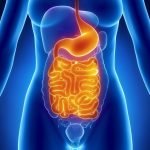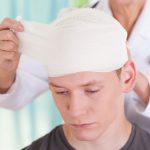CARRIE DECKER, ND
When we speak of hormones, we often think of those that play a role in mediating sexual function: estrogen, testosterone, and progesterone. These hormones come from the common base molecule of cholesterol, and all 3 derive from the mother hormone, pregnenolone (PREG), while estrogen and testosterone are also both downstream from dehydroepiandrosterone, commonly known as DHEA.
PREG is upstream of DHEA; it gives rise not only to DHEA but also to progesterone, cortisol, and other intermediary metabolites. The synthesis and metabolism of PREG primarily takes place in the adrenals, with the specific pathways and products varying by the adrenal location.1 Smaller amounts of PREG are also made in the gonads as well as the brain.2–4
Although we all are quite familiar with PREG as a mother hormone, many of us are not as familiar with the neurosteroid effects of PREG and its metabolites.
Peripherally and in the brain, PREG is metabolized to progesterone (PROG) and further converted to allopregnanolone (ALLO-P).5 Similar to DHEA and its sulfated form, DHEA-S, PREG also exists in a sulfated form, PREG-S, throughout the body including the brain.6 PREG, PROG, and ALLO-P each have been demonstrated to have neuroprotective effects.7 ALLO-P interacts with gamma-aminobutyric acid (GABA) receptors as an allosteric agonist; this may be a primary mechanism by which both PREG and PROG exert central nervous system (CNS) calming effects.8,9
As we grow in our understanding of the actions that PREG and its metabolites have in the brain, we see them increasingly being studied as therapies for conditions associated with neuroinflammation and CNS hyperexcitability, including epilepsy,10,11 schizophrenia,12 anxiety,13 depression,14 and traumatic brain injury,15 many of which we will look at further herein.
Age-Related Memory Decline
PREG and its derivatives may serve as a buffer for age-related hormonal decline, enhancing learning and memory, reducing dementia risk, enhancing locomotor activity, and promoting the growth and survival of brain cells.16,17 Much like other hormones, PREG declines with increasing age after it reaches its maximum levels at around 20 years of age.18,19
Memory formation and cognitive function, much like all things, rely on an appropriate balance of excitation and inhibition. In contrast to PREG and ALLO-P, PREG-S has GABA-inhibitory effects, which may be the mechanism by which the injection of PREG-S into rats’ brains was found to improve memory.20 A significant correlation between PREG-S and cognitive performance has been shown in animal models: rats with memory impairment tend to have much lower concentrations of the neurohormone as compared to rats with normal memory, whereas restoration of normal levels reversed memory deficits.17 PREG-S mediates many aspects of synaptic plasticity, that is, the connections between neurons that are responsible for their communication, the learning of new skills, and the formation of memory.21
As compared with healthy controls, patients with Alzheimer’s disease (AD) were found to have lower levels of PREG and its primary products, as well as DHEA-S (another downstream metabolite of PREG), in their brains.22,23 The sex steroids estrogen and testosterone also have been shown to be significantly lower in individuals with AD, particularly older females.24 Higher levels of the proteins, β-amyloid and hyperphosphorylated tau (proteins characteristic of AD25), are correlated with lower levels of the neurosteroids in certain regions of the brain.25 Animal studies have indicated that these neurosteroids may also reduce the damage that these proteins cause, thereby improving cellular survival.25
Although there are no studies to date specifically looking at PREG as a therapy for cognitive decline associated with aging, there are studies investigating its cognitive impact in other populations. We do see one small study point to the positive impact DHEA may have on brain health with aging: when taken at a dose of 25 mg daily for 6 months, DHEA was found to enhance cognitive function in women with mild-to-moderate cognitive impairment.26
In patients with schizophrenia, supplementation with PREG at escalating doses up to 500 mg/day for 8 weeks led to significant improvements in negative symptoms, with serum increases in PREG and ALLO-P predicting improvements in cognitive scores.27 A subsequent study in patients with recent-onset schizophrenia also found that supplementation of PREG at only 50 mg/day improved multiple markers of attention as well as executive function.28
Medications that specifically stimulate the brain’s production of PREG, PROG, and ALLO-P are currently under investigation as a treatment or prevention strategy for AD.29
Mental Health
Because of the impact neurosteroids have on CNS excitability and neural function, their role in anxiety and depression has also been studied.30 Interesting research has shown that ALLO-P and DHEA additionally modulate amygdala connectivity and our response to conditions that promote the emotion of fear.31
In a mouse study, lower serum levels of DHEA-S were observed in animals displaying a conditioned fear response, while administration of both DHEA-S and PREG-S (separately) dose-dependently reduced the anxiety response to conditioned fear.32 This sheds light on the impact these neurosteroids may have on conditioned fears – a factor in post-traumatic stress disorder (PTSD) – as well as on our arousal state and response to stress. Although the fear response is important and preserves our lives at times, we all can probably think of an instance in which being stoic and more functional in the face of our fears would be desired!
The effects of PREG on the emotional response has also been studied in humans in a task designed to assess emotional processing and regulation.33 When given 2 hours prior to performing the task, 400 mg of PREG altered multiple brain patterns (assessed by functional magnetic resonance imaging) prompted by the task. As compared to placebo, PREG reduced activity in the amygdala and insula, increased activity in the dorsal medial frontal cortex, and increased functional connectivity between the dorsal medial frontal cortex and the amygdala. These effects were associated with a reduction in self-reported anxiety.33
In young, otherwise-healthy unmedicated men with generalized anxiety disorder, lower serum levels of PREG-S were found, as compared to healthy controls.34 Lower serum ALLO-P levels were also observed in the men with anxiety; however, the difference was not significant; there was also no difference in DHEA-S levels between the 2 groups.34 Levels of ALLO-P have been shown to be significantly lower in men and women with PTSD and to be inversely correlated with PTSD and dysphoria symptoms.35
Treatment with PREG, at a dose of 100 mg/day for 8 weeks, was shown to have a positive impact on mood (but not cognition) in abstinent individuals being treated for substance use disorder, with trends toward greater improvement in scores for both manic and depressive symptoms.36 In a population of men and women with bipolar disorder not known to have substance use issues, PREG, titrated to 500 mg/day and taken for 12 weeks, also positively impacted depression remission rates compared to placebo, suggesting it may prove to be useful in this difficult-to-treat population.37
Studies also suggest PREG and its metabolites may have a positive impact on alcohol use disorder (AUD) specifically. Research has shown that plasma levels of ALLO-P are markedly lower in alcoholic subjects in early stages of withdrawal as compared to control subjects.38 In an animal model of AUD, self-administration of alcohol in rats with a preference for alcohol was significantly decreased by PREG.39 Additional animal research suggests that ALLO-P may help reduce alcohol use,40 giving rise to interest in further study of how this research may translate to humans as well.41 Low levels of PREG also have been observed in individuals with cocaine use disorder.42
Menstrual Cycle Disorders
Not surprisingly, PREG and its metabolites have also been investigated in women with hormonal-related mood disorders. In women with premenstrual syndrome, significantly lower serum levels of both ALLO-P and PROG were observed in the women during the luteal phase, as compared to controls.43,44 In women with post-partum depression, significantly lower levels of ALLO-P were shown, as compared to control women post-partum, with levels of ALLO-P and PREG both showing a significant negative correlation with Hamilton Rating Scale for Depression scores.45
One setting for which the underlying etiology suggests PREG may worthy of a therapeutic trial is hypothalamic amenorrhea, particularly as it pertains to women struggling with or in recovery from anorexia nervosa (AN). Hypothalamic amenorrhea is more common after intense metabolic, physical, or psychological stresses, of which AN is one.46 In women diagnosed with hypothalamic amenorrhea who have a normal body weight, lower levels of ALLO-P have been shown,47 and in those specifically in recovery from AN, a low DHEA-S to cortisol ratio also appears to be common.48 Research examining DHEA as a therapy for restoring the menstrual cycle in this population looks promising.49 Considering the general anxiety and fear-“dampening” effects of PREG and its downstream products, PREG also may be worthy of consideration.
Anti-Inflammatory Effects
Interesting research as far back as 1950 suggested that PREG may be useful for decreasing fatigue and treating inflammatory conditions such as ankylosing spondylarthritis [sic] and rheumatoid arthritis.50,51 Physicians at the time were already aware that the more potent glucocorticoids had several unwanted effects; hence, they had great interest in PREG as alternative anti-inflammatory treatment.52
Fast-forward to our modern, medication-laden era, and we still see research with PREG as a natural therapy for reducing pain. In fact, a 2019 study specifically details the many mechanisms by which PREG may impact pain and other inflammatory pathology via interactions with the innate immune system.53 PREG is not an immunosuppressant; however, similar to many of our other endogenous hormones, it acts to modulate inflammation and the immune system’s response to it.
ALLO-P levels have been shown to be inversely related to symptoms of pain in male veterans.54,55 This association was not limited to muscle pain; it included chest pain as well. Interestingly, a very strong association was also shown between a history of traumatic brain injury and muscle soreness, suggesting that some aspect of this symptomology may be centrally mediated. As the research discussed so far strongly supports the central anti-inflammatory effects of PREG, it is no surprise that this neurohormone has been studied in this special population, especially given the concomitant issues of PTSD, for which PREG may also be of benefit.56
A 2020 randomized, double-blind, placebo-controlled trial considered escalating doses of PREG (1 week at 100 mg/day, 1 week at 300 mg/day, and 2 weeks at 500 mg/day) for low back pain in Iraq- and Afghanistan-era military veterans.56 The population of veterans in this study was approximately 90% male and ranged in age from 18 to 65. Compared to placebo, PREG was shown to significantly reduce pain as well as the effects pain had on participation in other activities, including work. Both pain recall and pain diary scores progressively decreased and were significantly lower in the PREG group than in the placebo group by the study’s completion. Serum PREG levels approximately doubled after taking 100 mg for 1 week, and were almost 5 times greater after taking 500 mg for 2 weeks. ALLO-P and PREG levels increased more than 10-fold by the study’s completion as well. The intervention was well tolerated, with no significant adverse events being reported.56
Recent preclinical research suggests the PREG downstream metabolites, ALLO-P and PROG, may also improve neuropathic pain, another condition that is often difficult to treat.57,58
Potential Contraindications & Adverse Effects
With hormone precursors such as PREG or DHEA, adverse effects are generally not seen acutely, but may be with prolonged use. In the studies discussed herein, adverse effects related to PREG use were not seen despite the fairly high dosage; however, clinically, dysmenorrhea and mastalgia have been reported. With DHEA, adverse effects are mild and may include complaints of oily skin, hair growth, acne, and body odor59,60 – signs we typically associate with increased testosterone levels. Hair loss can also occur, as DHEA converts to more potent androgens in the follicle, which can interfere with hair growth.61 Studies suggest that the epidermal effects of DHEA may be related to steroidal production in the skin,62 which oral supplementation additionally enhances and to which some individuals may be more sensitive. Adverse symptoms may be averted by ensuring normal-to-low levels of hormones prior to initiation of treatment with the “mother hormones.”
It is worthwhile mentioning that the doses of PREG used in many of these studies are higher than practitioners typically use in clinical practice. Often, PREG or DHEA will be initiated at a low dose, and, if there are no complaints, the dose is gradually increased to levels shown to be effective. Micronization and dissolution into a lipid matrix supports the absorption of fat-soluble substances such as these63; hence, with such a preparation, clinical results may achieved at lower doses.
Closing Comments
Given the pleotropic actions of hormones, particularly those that are mother hormones to many others (such as PREG is), it is no surprise that we see such a broad range of biological effects. The research on PREG as an intervention for pain is quite unique, and given the positive findings discussed in the 2020 publication, it is likely we will see further research in this arena. Similarly, the findings supporting the use of PREG in addiction medicine and mental health are quite recent and are already being followed up by additional clinical trials.64,65
References:
- Stocco DM, Clark BJ. Regulation of the acute production of steroids in steroidogenic cells. Endocr Rev. 1996;17(3):221-244.
- Payne AH, Jaffe RB. Androgen formation from pregnenolone sulfate by fetal, neonatal, prepubertal and adult human testes. J Clin Endocrinol Metab. 1975;40(1):102-107.
- Ryan KJ, Petro Z. Steroid biosynthesis by human ovarian granulosa and thecal cells. J Clin Endocrinol Metab. 1966;26(1):46-52.
- Vallée M. Neurosteroids and potential therapeutics: Focus on pregnenolone. J Steroid Biochem Mol Biol. 2016;160:78-87.
- Akwa Y, Sananès N, Gouézou M, et al. Astrocytes and neurosteroids: metabolism of pregnenolone and dehydroepiandrosterone. Regulation by cell density. J Cell Biol. 1993;121(1):135-143.
- Harteneck C. Pregnenolone sulfate: from steroid metabolite to TRP channel ligand. Molecules. 2013;18(10):12012-12028.
- Wojtal K, Trojnar MK, Czuczwar SJ. Endogenous neuroprotective factors: neurosteroids. Pharmacol Rep. 2006;58(3):335-340.
- Bitran D, Shiekh M, McLeod M. Anxiolytic effect of progesterone is mediated by the neurosteroid allopregnanolone at brain GABAA receptors. J Neuroendocrinol. 1995;7(3):171-177.
- Brot MD, Akwa Y, Purdy RH, et al. The anxiolytic-like effects of the neurosteroid allopregnanolone: interactions with GABA(A) receptors. Eur J Pharmacol. 1997;325(1):1-7.
- Biagini G, Panuccio G, Avoli M. Neurosteroids and epilepsy. Curr Opin Neurol. 2010;23(2):170-176.
- Reilly MT, Crabbe JC, Rustay NR, Finn DA. Acute neuroactive steroid withdrawal in withdrawal seizure-prone and withdrawal seizure-resistant mice. Pharmacol Biochem Behav. 2000;67(4):709-717.
- Marx CE, Bradford DW, Hamer RM, et al. Pregnenolone as a novel therapeutic candidate in schizophrenia: emerging preclinical and clinical evidence. Neuroscience. 2011;191:78-90.
- Kardashev A, Ratner Y, Ritsner MS. Add-On Pregnenolone with L-Theanine to Antipsychotic Therapy Relieves Negative and Anxiety Symptoms of Schizophrenia: An 8-Week, Randomized, Double-Blind, Placebo-Controlled Trial. Clin Schizophr Relat Psychoses. 2018;12(1):31-41.
- Brown ES, Park J, Marx CE, et al. A randomized, double-blind, placebo-controlled trial of pregnenolone for bipolar depression. Neuropsychopharmacology. 2014;39(12):2867-2873.
- Bay E. Current treatment options for depression after mild traumatic brain injury. Curr Treat Options Neurol. 2009;11(5):377-382.
- Weng JH, Chung BC. Nongenomic actions of neurosteroid pregnenolone and its metabolites. Steroids. 2016;111:54-59.
- Mayo W, Le Moal M, Abrous DN. Pregnenolone sulfate and aging of cognitive functions: behavioral, neurochemical, and morphological investigations. Horm Behav. 2001;40(2):215-217.
- Hill M, Lukác D, Lapcík O, et al. Age relationships and sex differences in serum levels of pregnenolone and 17-hydroxypregnenolone in healthy subjects. Clin Chem Lab Med. 1999;37(4):439-447.
- Maki T. Age-related changes in secretion of adrenocortical steroid hormones in normal healthy men. Nihon Naibunpi Gakkai Zasshi. 1986;62(5):672-682. [Article in Japanese]
- Akk G, Bracamontes J, Steinbach JH. Pregnenolone sulfate block of GABA(A) receptors: mechanism and involvement of a residue in the M2 region of the alpha subunit. J Physiol. 2001;532(Pt 3):673-684.
- Smith CC, Gibbs TT, Farb DH. Pregnenolone sulfate as a modulator of synaptic plasticity. Psychopharmacology (Berl). 2014;231(17):3537-3556.
- Weill-Engerer S, David JP, Sazdovitch V, et al. Neurosteroid quantification in human brain regions: comparison between Alzheimer’s and nondemented patients. J Clin Endocrinol Metab. 2002;87(11):5138-5143.
- Marx CE, Trost WT, Shampine LJ, et al. The neurosteroid allopregnanolone is reduced in prefrontal cortex in Alzheimer’s disease. Biol Psychiatry. 2006;60(12):1287-1294.
- Akwa Y. Steroids and Alzheimer’s Disease: Changes Associated with Pathology and Therapeutic Potential. Int J Mol Sci. 2020;21(13):4812.
- Diniz BS, Pinto Júnior JA, Forlenza OV. Do CSF total tau, phosphorylated tau, and beta-amyloid 42 help to predict progression of mild cognitive impairment to Alzheimer’s disease? A systematic review and meta-analysis of the literature. World J Biol Psychiatry. 2008;9(3):172-182.
- Yamada S, Akishita M, Fukai S, et al. Effects of dehydroepiandrosterone supplementation on cognitive function and activities of daily living in older women with mild to moderate cognitive impairment. Geriatr Gerontol Int. 2010;10(4):280-287.
- Marx CE, Keefe RS, Buchanan RW, et al. Proof-of-concept trial with the neurosteroid pregnenolone targeting cognitive and negative symptoms in schizophrenia. Neuropsychopharmacology. 2009;34(8):1885-1903.
- Kreinin A, Bawakny N, Ritsner MS. Adjunctive Pregnenolone Ameliorates the Cognitive Deficits in Recent-Onset Schizophrenia: An 8-Week, Randomized, Double-Blind, Placebo-Controlled Trial. Clin Schizophr Relat Psychoses. 2017;10(4):201-210.
- Arbo BD, Ribeiro MF, Garcia-Segura LM. Development of new treatments for Alzheimer’s disease based on the modulation of translocator protein (TSPO). Ageing Res Rev. 2019;54:100943.
- Longone P, di Michele F, D’Agati E, et al. Neurosteroids as neuromodulators in the treatment of anxiety disorders. Front Endocrinol (Lausanne). 2011;2:55.
- Sripada RK, Welsh RC, Marx CE, Liberzon I. The neurosteroids allopregnanolone and dehydroepiandrosterone modulate resting-state amygdala connectivity. Hum Brain Mapp. 2014;35(7):3249-3261.
- Noda Y, Kamei H, Kamei Y, et al. Neurosteroids ameliorate conditioned fear stress: an association with sigma receptors. Neuropsychopharmacology. 2000;23(3):276-284.
- Sripada RK, Marx CE, King AP, et al. Allopregnanolone elevations following pregnenolone administration are associated with enhanced activation of emotion regulation neurocircuits. Biol Psychiatry. 2013;73(11):1045-1053.
- Semeniuk T, Jhangri GS, Le Mellédo JM. Neuroactive steroid levels in patients with generalized anxiety disorder. J Neuropsychiatry Clin Neurosci. 2001;13(3):396-398.
- Rasmusson AM, King MW, Valovski I, et al. Relationships between cerebrospinal fluid GABAergic neurosteroid levels and symptom severity in men with PTSD. Psychoneuroendocrinology. 2019;102:95-104.
- Osuji IJ, Vera-Bolaños E, Carmody TJ, Brown ES. Pregnenolone for cognition and mood in dual diagnosis patients. Psychiatry Res. 2010;178(2):309-312.
- Brown ES, Park J, Marx CE, et al. A randomized, double-blind, placebo-controlled trial of pregnenolone for bipolar depression. Neuropsychopharmacology. 2014;39(12):2867-2873.
- Romeo E, Brancati A, De Lorenzo A, et al. Marked decrease of plasma neuroactive steroids during alcohol withdrawal. Clin Neuropharmacol. 1996;19(4):366-369.
- Besheer J, Lindsay TG, O’Buckley TK, et al. Pregnenolone and ganaxolone reduce operant ethanol self-administration in alcohol-preferring p rats. Alcohol Clin Exp Res. 2010;34(12):2044-2052.
- Martin-García E, Darbra S, Pallarès M. Intrahippocampal allopregnanolone decreases voluntary chronic alcohol consumption in non-selected rats. Prog Neuropsychopharmacol Biol Psychiatry. 2007;31(4):823-831.
- Morrow AL, Boero G, Porcu P. A Rationale for Allopregnanolone Treatment of Alcohol Use Disorders: Basic and Clinical Studies. Alcohol Clin Exp Res. 2020;44(2):320-339.
- Milivojevic V, Covault J, Angarita GA, et al. Neuroactive steroid levels and cocaine use chronicity in men and women with cocaine use disorder receiving progesterone or placebo. Am J Addict. 2019;28(1):16-21.
- Monteleone P, Luisi S, Tonetti A, et al. Allopregnanolone concentrations and premenstrual syndrome. Eur J Endocrinol. 2000;142(3):269-273.
- Rapkin AJ, Morgan M, Goldman L, et al. Progesterone metabolite allopregnanolone in women with premenstrual syndrome. Obstet Gynecol. 1997;90(5):709-714.
- Nappi RE, Petraglia F, Luisi S, et al. Serum allopregnanolone in women with postpartum “blues”. Obstet Gynecol. 2001;97(1):77-80.
- Genazzani AD, Chierchia E, Santagni S, et al. Hypothalamic amenorrhea: from diagnosis to therapeutical approach. Ann Endocrinol (Paris). 2010;71(3):163-169.
- Meczekalski B, Tonetti A, Monteleone P, et al. Hypothalamic amenorrhea with normal body weight: ACTH, allopregnanolone and cortisol responses to corticotropin-releasing hormone test. Eur J Endocrinol. 2000;142(3):280-285.
- Andrisani A, Sabbadin C, Minardi S, et al. Persistent amenorrhea and decreased DHEAS to cortisol ratio after recovery from anorexia nervosa. Gynecol Endocrinol. 2017;33(4):311-314.
- Gordon CM, Grace E, Emans SJ, et al. Changes in bone turnover markers and menstrual function after short-term oral DHEA in young women with anorexia nervosa. J Bone Miner Res. 1999;14(1):136-145.
- Freeman H, Pincus G, Johnson CW, et al. Therapeutic Efficacy of Δ5-Pregnenolone in Rheumatoid Arthritis: Preliminary Observations. J Amer Med Assoc. 1950;142(15):1124-1128.
- Henderson E, Weinberg M, Wright WA. Pregnenolone. J Clin Endocrinol Metab. 1950;10(4):455-474.
- Deghenghi R, Boulerice M, Rochefort JG, et al. Antiinflammatory Δ4-Pregnenolone Derivatives. J Med Chem. 1966;9(4):513-516.
- Murugan S, Jakka P, Namani S, et al. The neurosteroid pregnenolone promotes degradation of key proteins in the innate immune signaling to suppress inflammation. J Biol Chem. 2019;294(12):4596-4607.
- Naylor JC, Kilts JD, Szabo ST, et al. Allopregnanolone Levels Are Inversely Associated with Self-Reported Pain Symptoms in U.S. Iraq and Afghanistan-Era Veterans: Implications for Biomarkers and Therapeutics. Pain Med. 2016;17(1):25-32.
- Kilts JD, Tupler LA, Keefe FJ, et al. Neurosteroids and self-reported pain in veterans who served in the U.S. Military after September 11, 2001. Pain Med. 2010;11(10):1469-1476.
- Naylor JC, Kilts JD, Shampine LJ, et al. Effect of Pregnenolone vs Placebo on Self-reported Chronic Low Back Pain Among US Military Veterans: A Randomized Clinical Trial. JAMA Netw Open. 2020;3(3):e200287.
- Patte-Mensah C, Meyer L, Taleb O, Mensah-Nyagan AG. Potential role of allopregnanolone for a safe and effective therapy of neuropathic pain. Prog Neurobiol. 2014;113:70-78.
- González SL, Meyer L, Raggio MC, et al. Allopregnanolone and Progesterone in Experimental Neuropathic Pain: Former and New Insights with a Translational Perspective. Cell Mol Neurobiol. 2019;39(4):523-537.
- Løvås K, Gebre-Medhin G, Trovik TS, et al. Replacement of dehydroepiandrosterone in adrenal failure: no benefit for subjective health status and sexuality in a 9-month, randomized, parallel group clinical trial. J Clin Endocrinol Metab. 2003;88(3):1112-1118.
- Finckh A, Berner IC, Aubry-Rozier B, So AK. A randomized controlled trial of dehydroepiandrosterone in postmenopausal women with fibromyalgia. J Rheumatol. 2005;32(7):1336-1340.
- Kasick JM, Bergfeld WF, Steck WD, Gupta MK. Adrenal androgenic female-pattern alopecia: sex hormones and the balding woman. Cleve Clin Q. 1983;50(2):111-122.
- Slominski A, Zbytek B, Nikolakis G, et al. Steroidogenesis in the skin: implications for local immune functions. J Steroid Biochem Mol Biol. 2013;137:107-123.
- Buster JE, Casson PR, Straughn AB, et al. Postmenopausal steroid replacement with micronized dehydroepiandrosterone: preliminary oral bioavailability and dose proportionality studies. Am J Obstet Gynecol. 1992;166(4):1163-1168.
- U.S. National Library of Medicine. ClinicalTrials.gov. Development of Pregnenolone as a Treatment for Depression R61. Study Identifier NCT03645096. Available at: https://clinicaltrials.gov/ct2/show/NCT03645096. Accessed December 3, 2020.
- U.S. National Library of Medicine. ClinicalTrials.gov. Feasibility Trial of Pregnenolone for Posttraumatic Stress Disorder and Alcohol Use Disorder. Study Identifier NCT04464148. Available at: https://clinicaltrials.gov/ct2/show/NCT04464148. Accessed December 3, 2020.

Carrie Decker, ND graduated with honors from the National College of Natural Medicine (now the National University of Natural Medicine) in Portland, OR. Prior to becoming a naturopathic physician, Dr Decker was an engineer and obtained graduate degrees in biomedical and mechanical engineering from the University of Wisconsin-Madison and University of Illinois at Urbana-Champaign, respectively. She continues to enjoy academic research and writing and uses these skills to support integrative medicine education as a writer and contributor to various resources. Dr Decker supports Allergy Research Group as a member of their education and product development teams.





